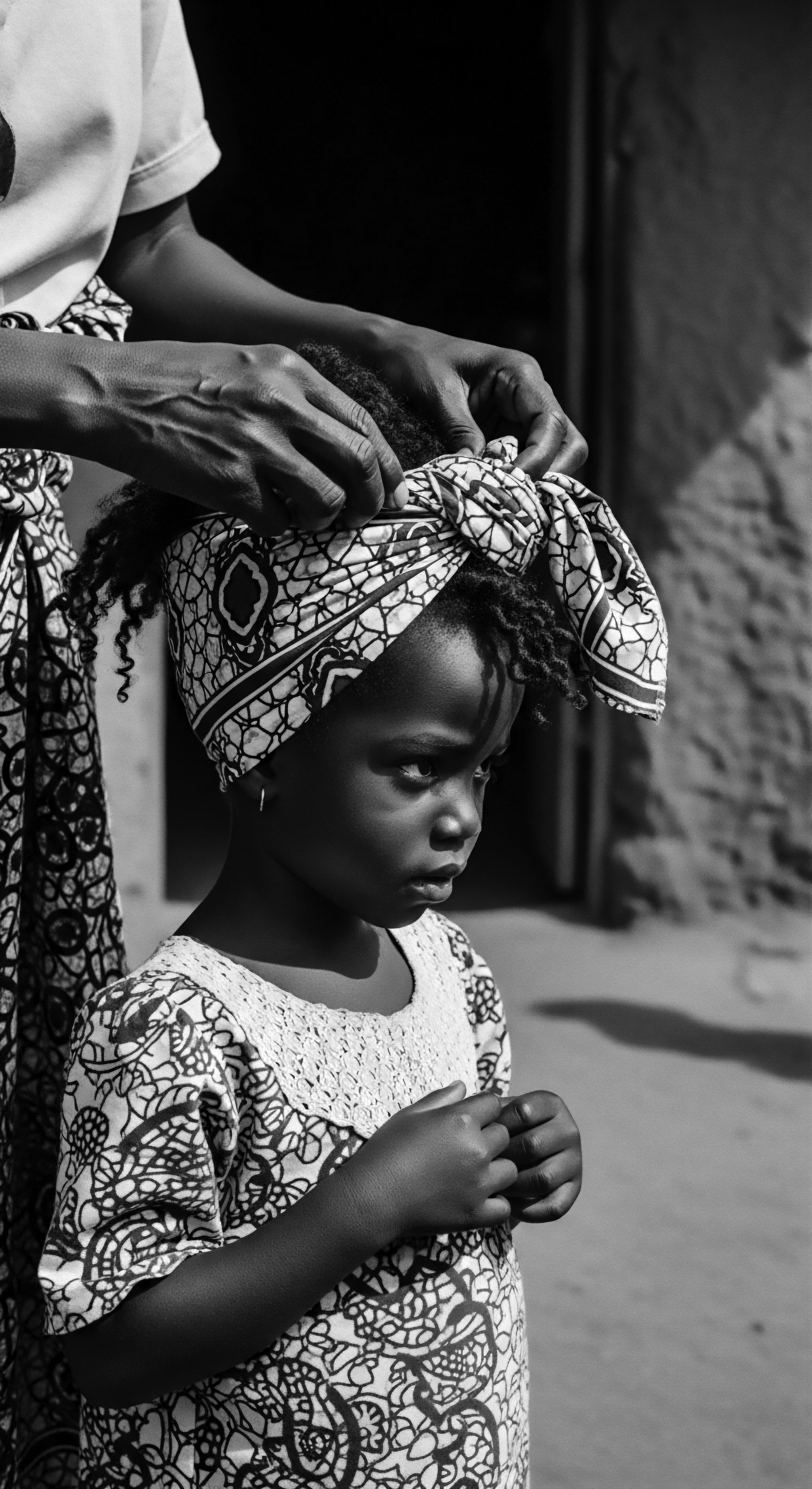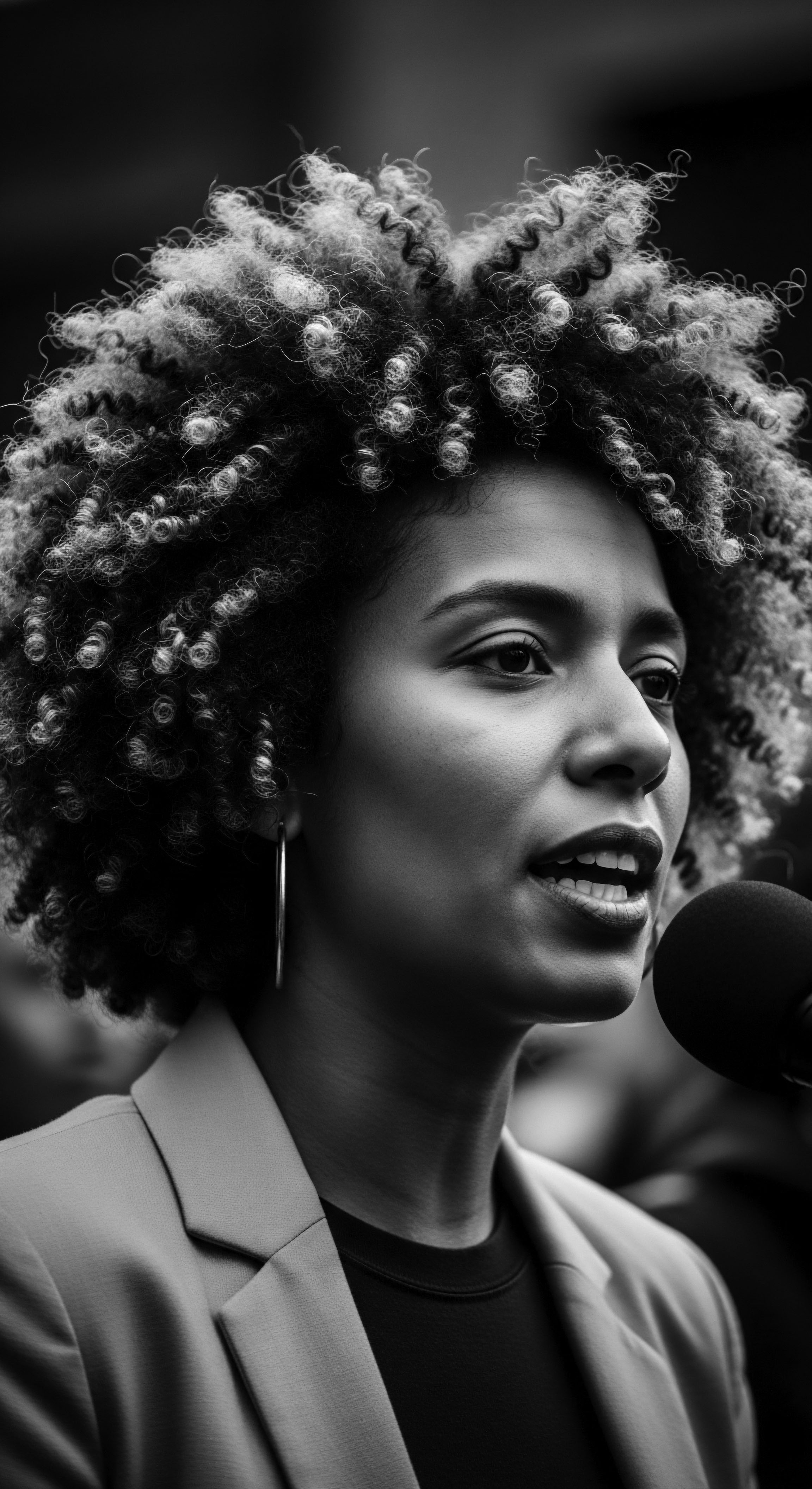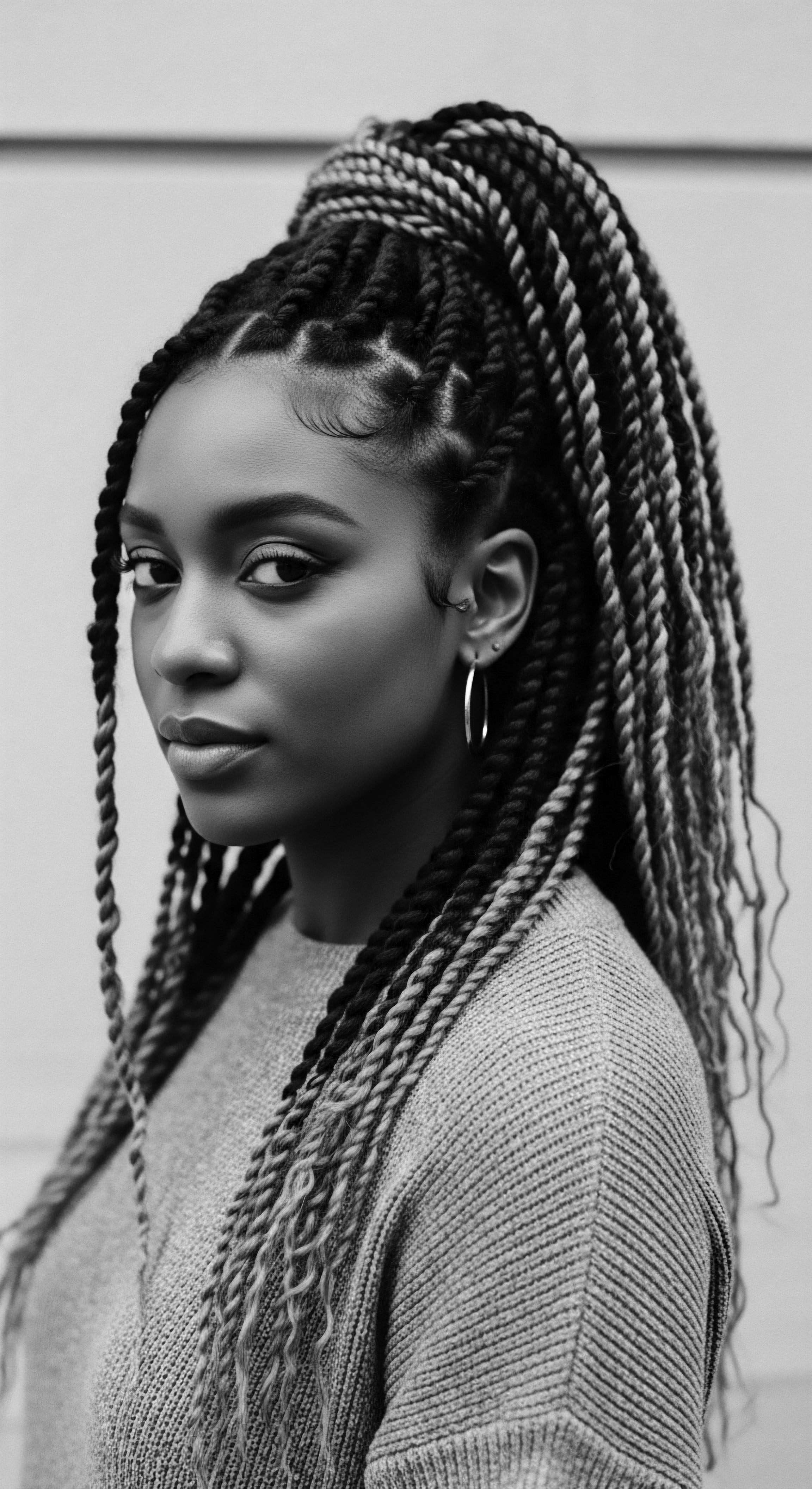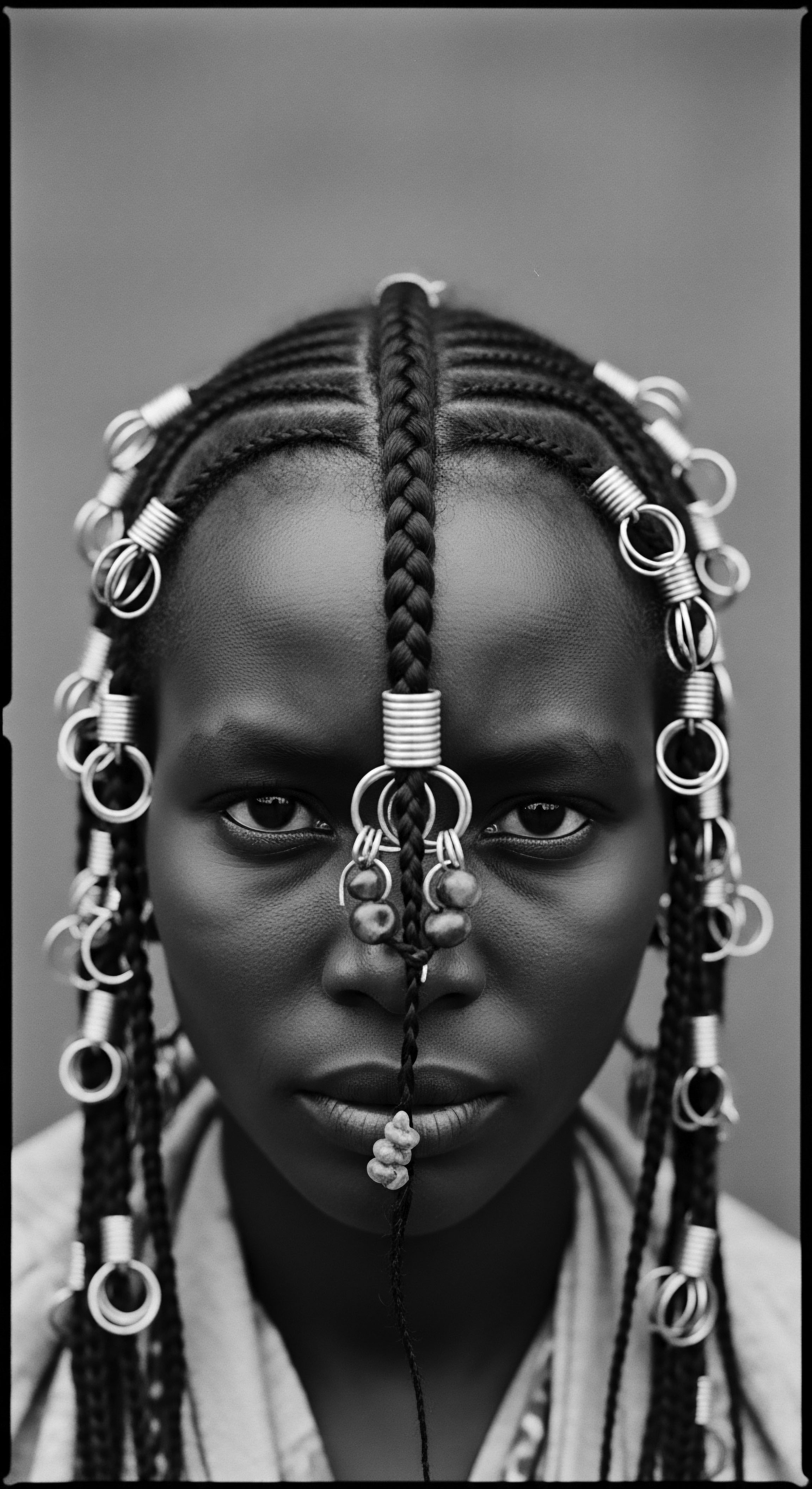
Roots
In the vast expanse of human experience, few elements hold such intimate connection to identity, spirit, and ancestral memory as hair. For individuals of African and mixed-race heritage, the coils and curves of textured hair are not simply biological structures; they are living archives, whispering tales of origins, resilience, and an unbroken line of wisdom. Before the profound disruption of the transatlantic slave trade, hair in African societies was a vibrant language unto itself, a complex grammar of status, spiritual belief, community belonging, and a family’s legacy. Braiding, in particular, transcended mere adornment; it was a communal ritual, a sacred act, passed from elder to child, rich with meaning.
The transatlantic slave trade, a dark chasm in human history, sought to sever these very connections. Upon forced arrival in the Americas, enslaved Africans faced a deliberate, brutal campaign to erase their personhood. A common tactic involved the shaving of heads, a calculated act intended to strip them of their cultural markers, their sense of self, and their dignity. This act aimed to render them undifferentiated, to sever the visible links to their homelands, their tribes, and their spiritual moorings.
Yet, even amidst such dehumanizing conditions, the spirit of those stolen people found ingenious avenues for defiance. Their textured hair, a physical manifestation of their lineage, became an unexpected canvas for a quiet, yet potent, rebellion.

Pre-Colonial Significance of Braided Heritage
Across the diverse tapestry of pre-colonial African societies, hairstyles were deeply emblematic. A braid’s pattern could communicate a person’s age, their marital status, their tribal affiliation, or their social standing. These were not fleeting fashion statements but deeply ingrained cultural practices, often tied to spiritual beliefs and life stages. The act of braiding itself fostered bonds; it was a communal activity where stories were shared, wisdom imparted, and connections reaffirmed.
Imagine the quiet strength exchanged during these sessions, the weight of generations held in each careful plait. This rich cultural heritage was violently disrupted, yet the memory of these practices, the understanding of hair as a conduit for identity, persisted.
- Social Standing ❉ The complexity or adornment of a style often indicated rank within a community.
- Tribal Affiliation ❉ Specific patterns and designs served as visual identifiers for different ethnic groups.
- Marital Status ❉ Certain styles could convey whether a person was married, single, or widowed.
- Spiritual Connection ❉ Hair was frequently viewed as a link to ancestral spirits and the divine.

Cultural Erasure and Initial Resilience
The journey across the Middle Passage was a horrific attempt at total annihilation of spirit. Beyond the physical torment, the deliberate act of shaving hair upon arrival in the ‘New World’ served a chilling purpose ❉ to erase the very identity rooted in African soil. It sought to break any remaining connection to ancestral ways, to obscure tribal origins, and to dismantle the visual language that had defined entire communities. This act of forced uniformity was a profound assault on the spirit, aiming to strip away the essence of who they were.
Yet, within the quiet spaces of the slave quarters, a profound act of defiance began to stir. The innate understanding of textured hair, its unique biology, and its historical significance, could not be entirely extinguished. The very act of caring for one’s hair, even in the harshest conditions, became a silent act of preservation, a small victory against systematic dehumanization. The deep coils and tight curls, resilient by nature, held the memory of freedom within their very structure.
The forced shearing of hair was a profound act of dehumanization, but it could not sever the deep-rooted cultural memory within each strand.

Ritual
From the depths of forced servitude, where every aspect of life was controlled, a quiet revolution took root within the intricate styling of textured hair. Braiding, once a symbol of social and spiritual meaning in African homelands, transformed into a clandestine language, a secret medium for survival and organized resistance. This was not merely about keeping hair neat, although that too was a defiant act in the face of conditions designed to breed despair.
This was about communication, about mapping freedom, about carrying the very seeds of future life within strands of hair. The act of braiding, often performed in hushed gatherings, transformed into an intimate ritual of defiance, weaving together hope and strategy with every interlocking section.

Braids as Coded Pathways to Freedom
One of the most remarkable ways braiding became a tool of resistance involved its use as a sophisticated, covert communication system. Enslaved women, through their deft hands and ancestral knowledge, could transform their hairstyles into topographical maps. Specific patterns, the direction of cornrows, or the number of braids, became coded messages. A coiled braid might signify a mountain path, while a sinuous design could direct towards a water source.
A thick braid could even signal the presence of a soldier along a planned escape route. This intelligence network, hidden in plain sight, allowed individuals to convey critical information about escape routes and meeting points without arousing suspicion from their captors. This practice allowed enslaved people to navigate the treacherous landscapes of their forced captivity, guiding their journeys towards liberty with a silent, yet powerful, cartography woven into their hair.
| Braiding Pattern Sinuous Braid |
| Coded Meaning for Resistance Indicated a water source or river. |
| Braiding Pattern Coiled Braid |
| Coded Meaning for Resistance Signaled a mountain or elevation. |
| Braiding Pattern Thick Braid |
| Coded Meaning for Resistance Could represent a soldier or military presence. |
| Braiding Pattern Departes Hairstyle |
| Coded Meaning for Resistance A style of thick braids tied into buns, signaling plans for escape. |
| Braiding Pattern These coded hairstyles allowed for silent communication, preserving pathways to freedom through the art of hair. |

What Sustenance Could Braids Conceal?
Beyond mapping routes, braiding also served a practical purpose of survival. In a world where enslaved individuals owned nothing, their hair became a discreet, portable vessel. Women would carefully braid small items into their cornrows ❉ rice seeds, small gold nuggets, or even tiny pieces of metal or matches. These seemingly innocuous additions were vital provisions for a perilous journey to freedom.
The rice seeds, for instance, were not simply food for the journey; they were a profound symbol of continuity. These seeds, often varieties brought directly from Africa, carried the promise of future sustenance, enabling escaped individuals to plant crops and cultivate new life in their newfound communities. This act, deeply rooted in ancestral agricultural practices, connected them to their homeland and offered a tangible means of self-sufficiency. The ability to carry such vital resources, concealed within the very texture of their hair, speaks to an incredible ingenuity born of desperation and an unwavering will to survive.
Braided hair transformed into a discreet pantry, holding seeds of future life and symbols of ancestral continuity.

Community and Collective Action
The act of braiding was rarely a solitary endeavor. It was a communal practice, often performed by women for one another, creating intimate spaces where secrets could be shared, plans whispered, and comfort extended. These sessions, carried out under the watchful eyes of enslavers, became a powerful form of collective resistance. As hands moved through hair, stories were exchanged, warnings passed, and strategies devised for both subtle and overt acts of defiance.
This shared ritual reinforced bonds between individuals, fostering a sense of solidarity and shared purpose that was crucial for survival. It was within these moments of shared care, of hands moving over textured coils, that the collective strength of a people denied their basic humanity was quietly affirmed. This continuity of care, rooted in pre-colonial traditions, became a vital thread in the fabric of resistance, maintaining a sense of community even when physical separation was enforced.

Relay
The echoes of braided resistance resonate through generations, a testament to the enduring human spirit and the profound power of cultural heritage. The story of braiding during the transatlantic slave trade extends far beyond individual acts of courage; it speaks to a systemic, collective will to survive, to preserve identity, and to claim freedom against insurmountable odds. This historical reality offers a deep understanding of how ancestral practices, particularly those surrounding textured hair, became critical tools for both practical survival and symbolic defiance. The impact of these acts continues to shape perceptions of Black and mixed-race hair, anchoring it in a legacy of strength and profound cultural meaning.

The Palenque De San Basilio Legacy
One of the most compelling historical examples of braiding as a tool of organized resistance comes from the community of San Basilio de Palenque, Colombia. This village, nestled in the jungle not far from Cartagena, was founded in the early 17th century by Maroons, enslaved Africans who had escaped their Spanish captors, led by the formidable Benkos Biohó. The women of Palenque de San Basilio are particularly renowned for their use of cornrows as a mapping system to guide others to freedom. They would observe the landscape during their forced travels and meticulously recreate the escape routes in their braided hairstyles.
These intricate designs, often hidden beneath head coverings, provided detailed intelligence for those planning their flight from enslavement. This remarkable strategy contributed directly to Palenque de San Basilio becoming the first free village of African heritage in the Americas, a fact formally recognized by the Spanish Crown in 1691. This case exemplifies how traditional hair practices, infused with ingenuity and collective purpose, directly enabled liberation and the establishment of self-governed communities.
The historical record shows that the detailed nature of these hair-maps was astonishing. As sociologist Lina María Vargas, drawing from the oral traditions passed down by her grandmother, explains, a braid could be finished vertically and upwards to signify a meeting under a tree, while a flattened braid towards the ears indicated a riverbank meeting point (Vargas, cited in Noireônaturel, 2022). This sophisticated system underscores the intellectual and strategic prowess of enslaved women, whose bodies became living archives of liberation. Their mastery of braiding, inherited from generations of ancestral practice, transformed into a powerful weapon in the struggle for self-determination.

Symbolic Dimensions of Resistance
Beyond the practical applications of mapping and concealing, braiding served as a vital form of symbolic resistance. In a system designed to strip enslaved individuals of their identity and culture, maintaining traditional hairstyles, or even simply caring for one’s textured hair, became a profound act of self-affirmation. The very act of styling hair, which was often a communal activity, reinforced a sense of shared identity and cultural continuity in the face of forced assimilation. Slave owners frequently imposed Eurocentric beauty standards, promoting the notion that straight hair was superior.
Yet, by continuing to braid, twist, and care for their natural coils, enslaved people quietly defied these oppressive ideals. This steadfast commitment to their ancestral hair practices became a powerful, visible statement of resistance, a refusal to fully surrender to the dehumanizing forces of slavery. It allowed them to retain a piece of their heritage, a link to the dignity and rich traditions of their African past.
Braiding transcended mere survival, serving as a powerful, silent assertion of cultural identity in the face of relentless oppression.

The Enduring Legacy of Braided Heritage
The lessons gleaned from the transatlantic slave trade and the role of braiding are not confined to dusty history books; they resonate deeply within the contemporary experience of textured hair. The practices of resistance have become a foundational element of Black and mixed-race hair heritage, shaping its meaning and significance today. Modern natural hair movements, for instance, draw directly from this lineage of defiance, celebrating the beauty and versatility of textured hair as an act of self-acceptance and cultural pride. The traditional techniques and styles, once used for survival, are now honored as expressions of identity, artistry, and connection to ancestral wisdom.
Understanding this profound history allows for a deeper appreciation of every braid, twist, or coil, recognizing in them not only an aesthetic choice but a living testament to generations of resilience. The wisdom encoded in these ancient practices continues to guide contemporary hair care, reminding us that the journey of textured hair is deeply intertwined with a legacy of strength, ingenuity, and an unwavering commitment to self-determination.
The intricate practices, passed down through generations, demonstrate the profound connection between the body, culture, and resistance. Even today, the act of braiding hair within Black communities often carries echoes of these historical moments, symbolizing continuity, community, and an enduring pride in one’s roots. This continuum of heritage is a testament to the power of human spirit to maintain identity and resist oppression through even the most personal and intimate of acts.

Reflection
To truly understand the textured strand is to acknowledge it as a living chronicle. It holds not only the intricate dance of its protein helixes but also the echoes of ancient hands, the silent wisdom of generations, and the resolute spirit of those who wielded it as a shield and a map. The ways in which braiding became a tool of resistance during the transatlantic slave trade are not merely historical footnotes; they are foundational chapters in the heritage of Black and mixed-race hair.
Each plait, each cornrow, each hidden seed, speaks to an ingenious refusal to be broken, a profound assertion of self in the face of systematic obliteration. This legacy reminds us that beauty, culture, and science are never separate entities; they are interwoven strands of a singular, enduring story.
The spirit of Roothea, our very ethos, finds its deepest resonance in this heritage. We recognize that the care for textured hair today is a continuation of ancestral practices, a mindful connection to the past, and a purposeful step towards a future where every textured crown is honored for its inherent magnificence and its powerful history. This exploration affirms that hair, in its myriad forms, remains a potent symbol of identity, an unbroken link to a powerful past, and a radiant beacon for what is yet to come.

References
- Adisa-Farrar, T. (2018). Our hair is a map to freedom ❉ What I learned about resistance from the “1st” free Black town in the Americas.
- Ancient Origins. (2022). African Slaves Used Braids to Communicate Escape Routes in Colombia.
- Beds SU. (2022). Black History Month 2022 ❉ The History Behind Cornrows.
- BLAM UK CIC. (2022). The history of Black Hair.
- Duncan, M. (2024). Freedom Braids. Lantana Publishing.
- Fulham Palace. (n.d.). Hair.
- Human Material Loop. (2025). The Hidden Meaning Behind Cornrows.
- Noireônaturel. (n.d.). How frizzy hair saved the lives of slaves.
- Odele Beauty. (2024). A History Lesson On Hair Braiding.
- Salford Students’ Union. (2024). The Remarkable History Behind Black Hairstyles.
- Rose, S. (2020). How Enslaved Africans Braided Rice Seeds Into Their Hair & Changed the World.
- Substack. (2025). Ancestral Hair Rituals to Nourish Your Hair and Soul.
- The Queen’s Journal. (2025). History, identity, and community ❉ The significance of Black hair.
- Tourism Colombia. (n.d.). Traditional hairstyles and drums.
